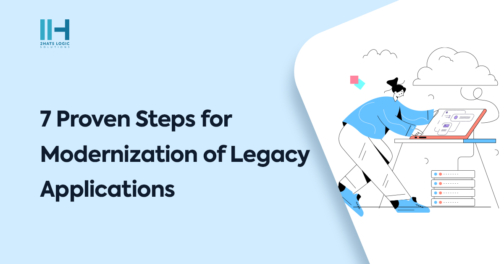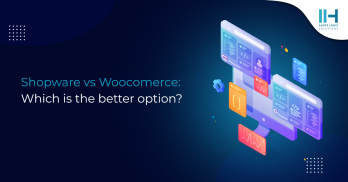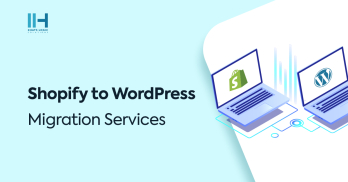Greetings! I'm Aneesh Sreedharan, CEO of 2Hats Logic Solutions. At 2Hats Logic Solutions, we are dedicated to providing technical expertise and resolving your concerns in the world of technology. Our blog page serves as a resource where we share insights and experiences, offering valuable perspectives on your queries.

The digital world is in constant evolution and necessitates businesses to swiftly modernize their legacy applications. Adaptability is key in meeting changing consumer expectations and staying competitive amid technological advancements.
This article outlines 7 proven steps for the modernization of legacy applications, offering a strategic guide for businesses aiming to grow in the dynamic e-commerce sector.
What is Legacy application?
Legacy applications are outdated software or systems that are critical to operate and face challenges in meeting modern business needs. Typically developed with outdated technologies, they lack compatibility with current standards. Modernization involves updating or migrating these applications to contemporary architectures, languages, and frameworks. This ensures improved performance and relevance in today’s rapidly evolving technological landscape.
Benefits of Modernizing Legacy Applications
1. Enhanced Performance
Upgrading legacy applications improves their performance, making them more efficient and responsive. This ensures that users experience faster load times, smoother interactions, and overall improved functionality, contributing to a more positive user and customer experience.
2. Increased Security
Modernization addresses security vulnerabilities present in outdated systems. By implementing the latest ecommerce security measures, organisations can better protect sensitive data. It helps to reduce the risk of cyber threats and ensure compliance with current security standards.
3. Scalability
Modernized applications are designed to scale more effectively, accommodating increased user loads and growing data volumes. This scalability is crucial for businesses experiencing expansion or changes in demand. This maintains a seamless and cost-effective response to growth.
4. Improved Integration
Upgraded systems facilitate better integration with modern technologies and third-party solutions. This connectivity enhances collaboration between different systems, departments, and external platforms. It streamlines processes and improves overall organizational efficiency.
5. Cost Savings
Modernization can lead to significant cost savings over time. While there might be an initial investment, the organization experiences long-term financial benefits. These arise from reduced maintenance costs, improved efficiency, and avoidance of issues associated with outdated systems.
Say Goodbye to Slow, Vulnerable Websites. Embrace the Power and Security of Laravel:
Steps to Modernize Legacy Applications
1. Assess & Prioritize
Application modernization begins with a comprehensive assessment of the existing application landscape. Create an inventory, diving deep into each application’s functionality, dependencies, and technical state.
Identify the drivers for modernization that align with key business goals, such as improving user experience, enhancing scalability, or addressing security concerns. This systematic approach ensures a strategic and efficient modernization roadmap.
2. Choose the Right Approach
Selecting the appropriate modernization approach is crucial. Assess a range of options, including refactoring, replatforming, rebuilding, containerization, cloud migration, or API encapsulation.
Align the chosen approach with specific organizational needs; rehosting may be suitable for simpler migrations while rewriting might be necessary for substantial architecture changes. Make the most of existing tools and frameworks, like cloud environments and microservices, to simplify the modernization process and optimize results.
3. Focus on User Experience
Prioritizing user experience is crucial in the modernization of applications. Beyond functional improvements, prioritize intuitive and user-friendly UI/UX redesigns. Take into account accessibility for diverse users and devices to ensure inclusivity. A meticulous focus on user experience not only meets current expectations but also future-proofs applications in the dynamic digital landscape.
4. Embrace Agility and DevOps
The adoption of an agile mindset and DevOps practices is crucial in modernization efforts. Break down monolithic applications into smaller, independent services, fostering agility and scalability. Implement iterative development and continuous integration/continuous delivery (CI/CD) pipelines to accelerate updates and releases. Automation of testing and deployment processes enhances efficiency and maintains high-quality standards throughout the modernization journey.
5. Prioritize Security and Compliance
Security and compliance considerations must be integrated seamlessly into the process of application modernization. This involves embedding security features throughout the development lifecycle.
Adhere to relevant industry regulations and data privacy standards, ensuring the confidentiality and integrity of sensitive information. Choose secure cloud platforms and infrastructure to fortify the overall security posture, safeguarding applications against evolving cyber threats.
6. Ensure Data Migration and Integration
To ensure a successful modernization process, a well-defined data migration strategy is essential. Pay meticulous attention to integrating modernized applications, including website migration, with existing systems and databases seamlessly. This approach helps minimize downtime and data loss. Prioritize data security and governance throughout the migration to ensure that sensitive information remains protected.
7. Invest in Training and Change Management
Successfully navigating application modernization requires investing in the people driving the change. Equip your team with the necessary skills and knowledge to navigate new technologies seamlessly.
Communicate modernization goals and benefits to all stakeholders, fostering understanding and alignment. Establish ongoing support mechanisms and training programs to ensure sustained user adoption and the overall success of the modernization initiative.
Say Goodbye to Slow, Vulnerable Websites. Embrace the Power and Security of Laravel:
Conclusion
In conclusion, the modernization of legacy applications is a crucial step for businesses to stay competitive in the dynamic digital landscape. By following the outlined 7 proven steps, organizations can enhance overall performance. Investing in the right approach, including the utilization of full stack developer, data migration, and the training of teams ensures a smooth transition and sets the foundation for sustained success. Application modernization is not just about keeping up; it’s about thriving in the evolving technological era. Upgrade your journey by modernizing your legacy system with expert services to make use of the full potential of your digital transformation.
FAQ
What is legacy system modernization, and why is it important for businesses?
Legacy system modernization refers to the process of updating or migrating outdated software or systems to contemporary architectures, languages, and frameworks. Businesses must ensure their applications remain relevant, efficient, and secure in the rapidly evolving digital landscape.
Why should organizations invest in modernizing their legacy applications?
Organizations should invest in modernization to enhance the performance, security, and scalability of their applications. This proactive approach not only improves user experience but also helps in adapting to changing consumer expectations and staying competitive in the market.
What are the key benefits of modernizing legacy applications?
The key benefits include enhanced performance, increased security through the implementation of modern security measures, improved scalability to accommodate growth, better integration with modern technologies, cost savings over time, and overall organizational efficiency
How do businesses determine the right modernization approach for their legacy applications?
The right modernization approach is determined by assessing various options, such as refactoring, re-platforming, rebuilding, containerization, cloud migration, or API encapsulation. Organizations should align the chosen approach with their needs and leverage existing tools and frameworks to optimize the modernization process.
What role does user experience play in the modernization of legacy applications?
User experience is a critical aspect of modernization. Beyond functional improvements, organizations should prioritize intuitive and user-friendly UI/UX redesigns. This ensures not only meeting current user expectations but also future-proofing applications in the dynamic digital landscape.

Related Articles






